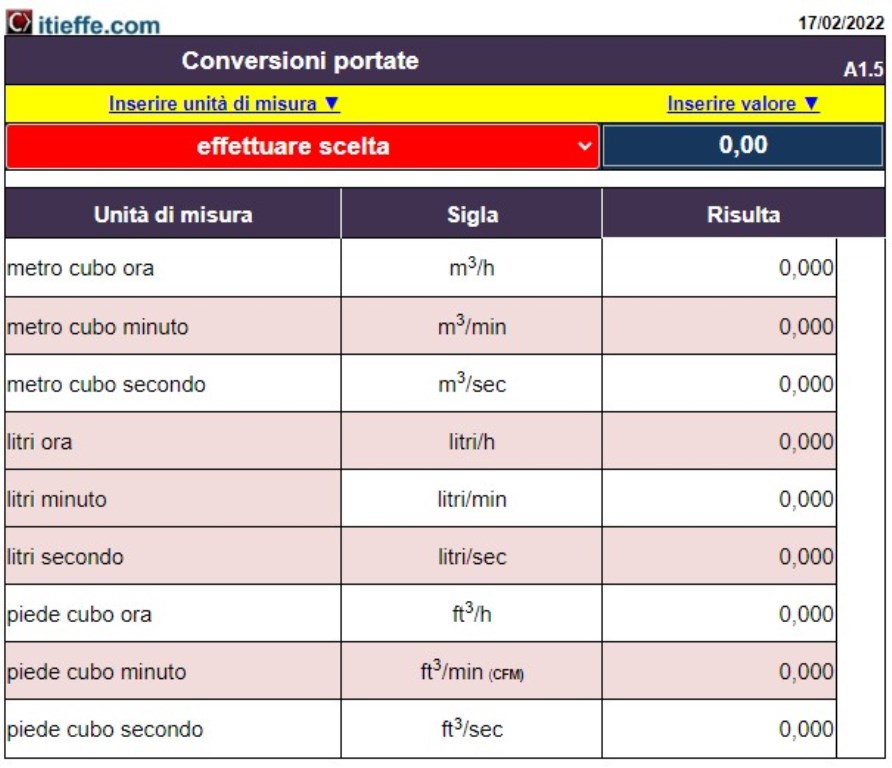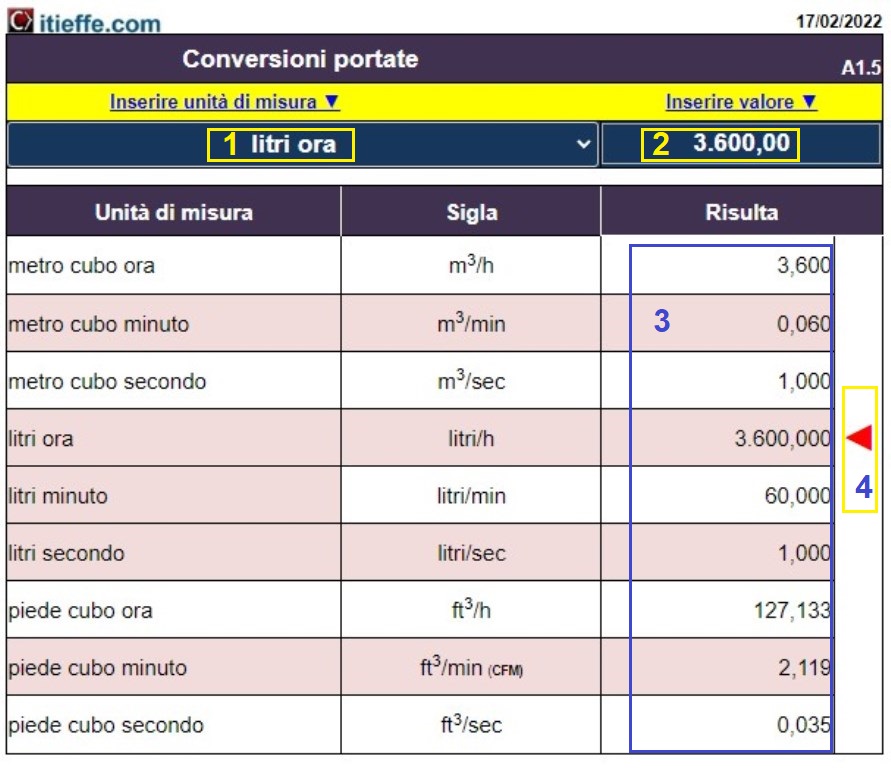Flow rate conversions

Simultaneous conversion of all values. By indicating one quantity you immediately have the value of all the others – Enter the known value in the corresponding cell and press enter
Welcome to the “Flow Conversions” program. In a world where managing and understanding the flows of materials, liquids or gases are critical to a wide range of industries, it is essential to master the conversions between different units of flow measurement.
Whether you are involved in engineering, the food industry, ecology, or any other field where the flow of substances is crucial, this program is here to help you make precise and meaningful conversions. We will learn together how to easily navigate between liters per second, gallons per minute, cubic meters per hour and much more.
Regardless of your level of experience or the context in which you operate, the program created by Itieffe will provide you with the knowledge and tools necessary to confidently face the challenges related to flow management. Prepare to discover the interconnection between different scales of scope and become an expert in converting between them.
Flow rate conversions
Online conversion of pressure values.
By indicating the quantity of one quantity, one immediately has the value of all the others at the same time.
The flow rate is the quantity of fluid that passes through a section with area “A” in the unit of time.
Given a section, a weight flow rate can be defined if it refers to the weight (mass multiplied by the gravitational acceleration equal to 9,80665 m / s2), a mass (or mass) if it refers to the mass of fluid and a volumetric flow rate if it refers to the volume .
Insights
Flow rate conversions
Flow
In a pipe in which a liquid flow flows, the flow rate is defined precisely by the volume of flow (generally water) that crosses a section normal to the pipe itself in the unit of time.
indicating the flow rate with P, the speed with V and the section of the pipe with S we will have that:
P = S x V
Example: if the speed (V) is expressed in m / s (meters / second) and if the section of the pipe (S) is expressed in m² (square meters) the flow rate will be expressed in m³ / s (cubic meters per second) .
We remind you that generally in the plumbing and heating tables the flow rate is expressed in different units of measurement:
m³ / h (cubic meters per hour)
l / h (liters per hour)
l / min (liters minute)
l / s (liters per second)
Switching from one to the other is very simple.
To give an example: knowing that 1 hour is worth 60 minutes, that 1 minute is worth 60 seconds, that the hour is made up of 3.600 seconds and that 1 cubic meter of water is equivalent to 1.000 liters, a flow rate of 36 m³ / h, is equivalent to saying:
36.000 l / h (36 x 1.000);
600 l / min (36.000 / 60);
10 l / sec (600/60).
In a pipeline with different pipe diameters, with the same flow rate, the speed varies.
With the same flow rate in the section with a smaller diameter, the speed of the fluid will be greater (and vice versa).
The relation P = S x V
properly used and knowing two elements, it allows the determination of the third (example - “S1 = P / V1” - “V1 = P / S1”).

This is to remain in the field of volume flows; not to be confused with the mass flows which are instead evaluated in kg / h or in kg / s.
In thermo-hydraulic calculations, in which water is the most used vector fluid (water has a specific mass close to unity: 1 kg has the volume of 1 liter) the numerical value with which we define the flow size is often completely identical, so a flow rate of 36.000 l / h (volume) is written and calculated for simplicity, as 36.000 kg / h (mass) not only when it comes to water at 4'C but almost always and without consequences of prominence in the results of more normal calculations.
When it comes to choosing the diameter of the pipes suitable for conveying a certain flow rate P, the sliding speed parameter V is to be kept in due attention.In fact, everyone knows that excessive speeds can create noise, high pressure drops ( and consequently pumps with high head and electrical absorption) cavitation phenomena and also water hammer.
The maximum speed limit values are linked not only to the internal diameter and roughness of the pipeline, but also to the temperature of the fluid itself, its static pressure and the type of system.
We must also consider that very low V values mean larger pipe diameters which lead to increasing not only the living costs of the distribution network and installation, but also the passive heat losses that will accompany the plant throughout its life.
The following link Maximum system water speed, offers optimal maximum speed values within which noise phenomena are avoided, without however exceeding the size of the diameters or exaggerating the continuous pressure drops. The fluid must obviously be well deaerated (see how to make air vents) as the possible presence of air pockets is often the first source of “flow” noises.
Instructions
Flow rate conversions

How to proceed
1 – Choose the unit of measurement (box 1),
2 – Enter the value (box 2),
press enter or click inside the program.
3 – All the conversions made will be displayed immediately (box 3).
4 – The arrow indicates the chosen unit of measurement
Other free programs of the same kind offered by itieffe ▼
Flow rate conversions
The program below is free to use.
To access the reserved version (see below), full page and without advertising, you must be registered.
You can register now by clicking HERE
